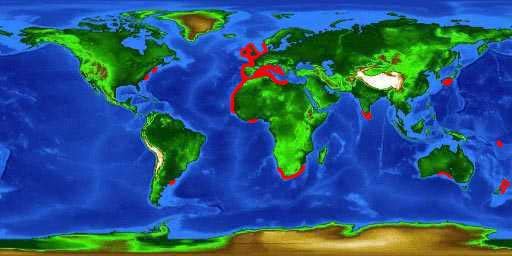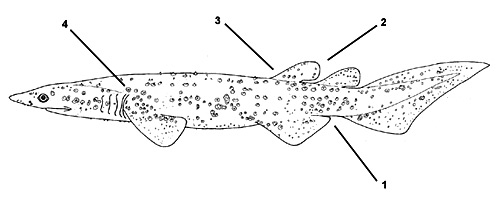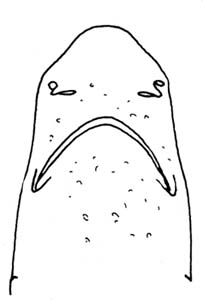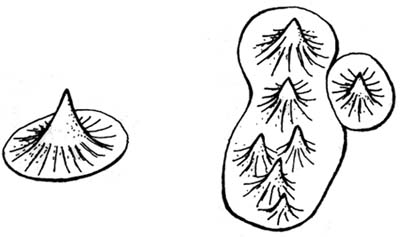Bramble Shark

Echinorhinus brucus
This short, stout shark is suited to its life as a deep-sea dweller. It lacks the classic prominent ‘shark’ dorsal fin, having two small dorsal fins placed far back on its body, and most of its other fins are small and set back, including an asymmetrical caudal (tail) fin. Is tends to be dark shades from olive or purple, to dark gray or black, scattered irregularly with distinct thorn-like denticles or groups of denticles. Because it’s a deep water shark, it is rarely seen or even caught, so it is considered no threat to humans.
Order – Squaliformes
Family – Echinorhinidae
Genus – Echinorhinus
Species – brucus
Common Names
English language common names include bramble shark, mango-tara, spinous shark, and spiny shark. Common names in other languages include achinoskylopsaro (Greek), Alligatorhai (German), Braamhaai (Afrikaans/Dutch), Brombeerhai (German), chenille (French), civili köpek baligi (Turkish), kalb (Arabic), karcharias (Greek), kavouromana (Greek), kikuzame (Japanese), murruna tal-fosos (Maltese), murruna tax-xewk (Maltese), murruna xewwikija (Maltese), Nagelhai (German), okahai (Finnish), peixe-prego (Portuguese), peshkagen therrës (Albanian), pex tachuela (Spanish), pez clavo (Spanish), pez tachuela (Spanish), prego (Portuguese), rekin kolczasty (Polish), ronco (Italian), rubioca (Spanish), squale bouclé (French), stachelhai (German), sømhaj (Danish), tagghaj (Swedish), tiburón de clavos (Spanish), tubarâo-prego (Portuguese), and tubarão-prego (Portuguese).
Importance to Humans
The bramble shark is sometimes caught by anglers as a gamefish. It may be used in traditional medicine in southern Africa as well as processed into fishmeal.
Danger to Humans
The bramble shark is harmless to humans.
Conservation
> Check the status of the bramble shark at the IUCN website.
According to the World Conservation Union (IUCN), the bramble shark is a rare deepwater shark which has only been recorded sporadically and usually solitarily at widely dispersed localities throughout the world. Although very little is known about its life history, it is likely to be a slow-growing, late-maturing species. It is not taken in commercial fisheries due to the depth at which it occurs, however there is some published data on the decline of this species in the northeast Atlantic in recent times. At the present time, there is a lack of data to assess the conservation status of the bramble shark. Since it is taken, although infrequently, as fisheries bycatch, along with its probable limiting life history characteristics, the bramble shark may well meet the criteria for the “Threatened” category as more data becomes available.
Geographical Distribution

There have been five reports of the bramble shark in the western North Atlantic Ocean region. These range from Cape Cod, off the Virginia coast, and the northern Gulf of Mexico. In the eastern Atlantic, this shark has been observed from the North Sea Southward to Ivory Coast, including the Mediterranean Sea. This species is also known in the south Atlantic from Argentina in the west and from Namibia to the Cape of Good Hope in the east. Elsewhere they have been caught in the Indian Ocean and in the western Pacific Ocean.
Habitat
The bramble shark is primarily a deepwater, bottom-dwelling shark that are found on deeper portions of the continental shelf and upper slope. The recorded depth range is 60-2,950 feet (18-900 m), however they are much more common at depths greater than 650 feet (200 m). It is considered a rather sluggish shark.
Distinguishing Characteristics

1. Anal fin is absent
2. Dorsal fins are spineless
3. Dorsal fins are located far back with the first dorsal fin located behind the origins of the pelvic fins
4. Large, thorn-like denticles are scattered on body and fins
Biology
Distinctive Features
The body of the bramble shark is stout, soft and flabby with a cylindrical trunk. The snout is short and depressed and the gill openings are large, especially the fifth. Large denticles cover the ventral side of the snout. The mouth is broadly arched with short labial folds. The nostrils are widely spaced apart and have short anterior flaps. Spiracles are present posterior to the eyes. There are two equally sized, spineless dorsal fins located far back on the body, just posterior to the origin of the pelvic fin. Precaudal pits are present; the caudal fin lacks a subterminal notch. There is no anal fin present.
This shark may be confused with the Greenland shark (Somniosus microcephalus) but differ in having: (1) the first dorsal located just behind the origin of the pelvic fins (instead of about midway between the latter and the pectorals), (2) a very different tail shape, (3) large thornlike denticles, (4) larger gill openings, and (5) teeth that are similarly shaped in the two jaws (instead of unlike).

Coloration
This deepwater shark is dark gray, olive, purple, black, or brown with metallic reflections on the dorsal side. It occasionally has darker blotches. Ventrally, it is pale brown or gray to white. The denticles have been described as luminescent, however there are no special luminous organs.
Dentition
The multicuspid teeth are similar in both jaws. Each is strongly compressed with a single cusp and up to three cusplets. These cusplets are lacking in juveniles. The teeth are curved toward the corners of the jaws, forming a cutting blade. The upper jaw contains 20-26 teeth while the lower jaw has 22-26 teeth.
Dermal Denticles
The bramble shark has skin that is thin and delicate. The body and fins are irregularly covered with large to small bucklers. Single bucklers have round bases and radiating ridges and are conically-shaped. Often a series of two or more bucklers coalesce to form large plates (15-25 mm) with multiple cusps. Large denticles are located ventral of the snout.
Size, Age & Growth
The maximum reported size of the bramble shark is 3.1m total length (TL). Males mature at 4.9-5.7 feet (1.50-1.74 m) and females at 7-7.5 feet (2.13-2.30 m). Total length-weights at selected sizes include 11.8 inches (embryo)/0.24 pounds, 59 inches/44 pounds, 63 inches/64 pounds, 67 inches/99 pounds, 85 inches/172 pounds, and 100 inches/300 pounds (30 cm (embryo)/110 g, 150 cm/20 kg, 162 cm/29 kg, 170 cm/45 kg, 216 cm/78.2 kg, and 254 cm/136 kg).

Food Habits
Bramble sharks eat a variety of bony fishes, small sharks, and crabs.
Reproduction
This shark has an ovoviviparous reproductive mode. The females have 15-24 pups per litter which each measure 15.7-19.7 inches (40-50 cm) total length. The reproductive cycle and gestation period are unknown for this species.
Predators
Potential predators include large fish and sharks residing in the same habitats and depths as the bramble shark.
Parasites
There are no available detailed studies on parasites of the bramble shark.
Taxonomy

Originally described as Squalus brucus by Bonaterre in 1788, this shark’s name was later changed to the currently valid Echinorhinus brucus (Bonaterre 1788). The genus name Echinorhinus is derived from the Greek echinos meaning “sea urchin, hedgehog” and from rhinos meaning “nose”. Synonyms used in past scientific literature include Echinorhinus spinosus Gmelin 1789, Squalus spinosus Gmelin 1789, Echinorhinus obesus Smith 1838, and Echinorhinus mccoyi Whitley 1931.
Prepared by: Cathy Bester and George Burgess